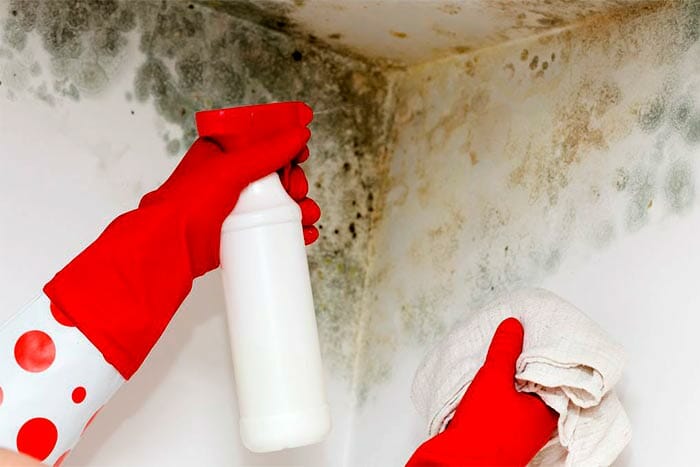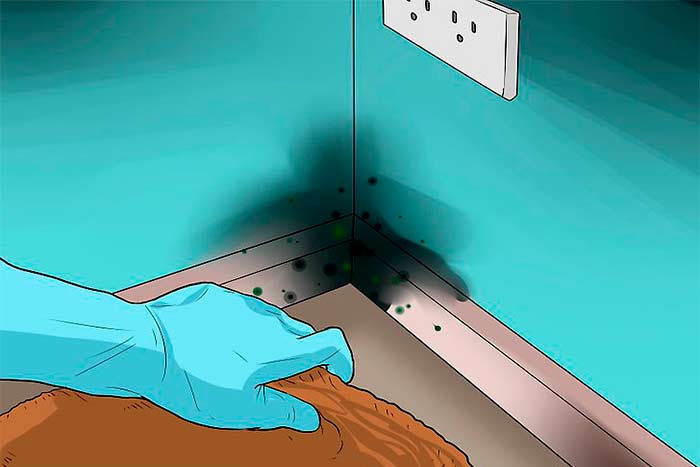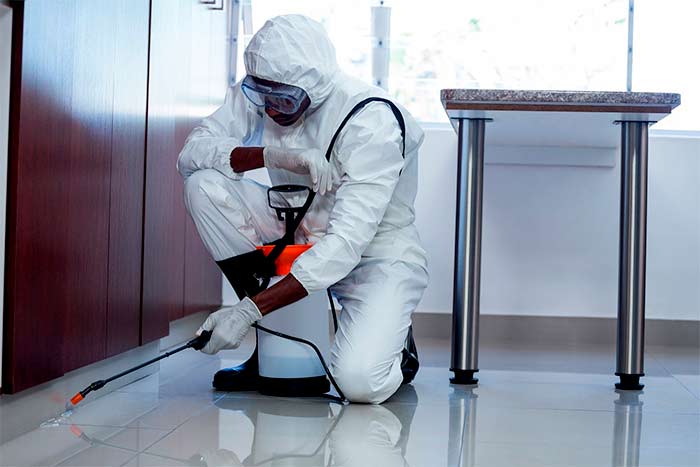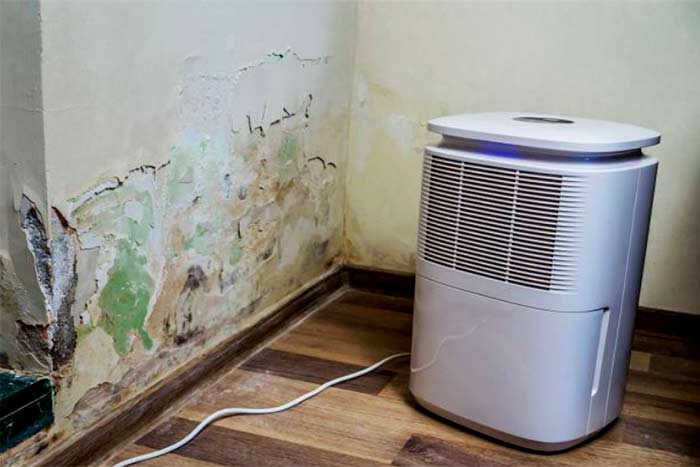Basements usually offer the ideal environment for mold growth due to their typical moisture content and limited access to sunlight and fresh air.
Mold in your basement move upstairs, if other areas of your home provide a damp, moist environment that mold spores can grow on. Mold spores can travel through vents and contaminate your breathable air without mold actually needing to grow upstairs.
Having mold in one room of your house doesn’t have to be a bad sign for mold in the rest of your home, however. If you keep your home dry and well-ventilated and tackle any mold growths as soon as they appear, then you stand a very good chance of preventing the spread of mold within your home.
How does mold move from basement to upstairs?

In order for it to flourish and grow, mold requires three key environmental factors. These are a damp or moist environment, adequate nutrients to feed on, and material or surface to grow on.
If the upstairs area of your home offers such an environment, then mold can easily spread from your basement by means of tiny, lightweight mold spores. These spores can travel easily through the air and are the main means by which mold reproduces and spreads.
As mold spores are very small and extremely lightweight, they can travel easily throughout your home. Whether they land on your clothing or your pet’s fur or even travel on natural air currents in your home, a mold problem can soon spread if you have moisture issues throughout your property.
Moisture and dampness problems can present in a variety of ways. They could come about as the result of a flood, a leaky pipe, or even cracked foundations in your home.
As such, the best and surest means of preventing a mold problem from spreading throughout your home is to address any moisture or dampness issues as soon as they arise, and by maintaining a dry, well-ventilated environment that is inhospitable to mold growth.
How far can mold spores travel in the air?
Mold spores will remain airborne for as long as there is an air current to carry them. They are microscopic and extremely lightweight, and so are predisposed to spreading in this manner.
There is always some level of mold present in your home, so you shouldn’t worry too much about the spread of mold spores on your property. Instead, concentrate on keeping your home dry and well-ventilated, and don’t give the mold spores a moist home to land on!
How to stop the spread of mold spores
There are several ways to help stop the spread of mold spores in your home, mostly to do with controlling moisture and dampness levels. Some recommendations from the Centers for Disease Control and Prevention include:
- Always promptly fix any obvious areas of water ingress in your home, such as leaky roofs, windows, and pipes.
- If your home experiences a flooding event, ensure you thoroughly clean and dry everything that was exposed to water.
- Keep certain areas of your home that are prone to dampness well-ventilated; these include your bathroom, laundry, and kitchen.
- Keep humidity levels in your home as low as possible — humidity levels between 30% and 50% are a good rule of thumb – using an air conditioner or dehumidifier.
- Avoid carpeting rooms or areas of your home that typically have a lot of moisture, such as bathrooms and basements.
Basement mold health risks
The health risks posed by basement mold are identical to the health risks presented by mold growths that pop up in other rooms and areas in your home.
Some people might not have any obvious reaction to mold in their homes. For others, however, mold exposure can give rise to serious and debilitating symptoms. The people most at risk are usually children, the elderly, people with mold allergies, and asthmatics.
Some symptoms of mold exposure include:
- Respiratory symptoms and difficulties: A blocked or stuffy nose, sneezing, coughing, and even shortness of breath.
- Eye and skin complaints: Red, itchy eyes and rash-like symptoms.
- Asthma: Asthmatic complaints and asthma attacks.
If you are suffering any of the above symptoms, but have not been diagnosed with a mold allergy, you may need to see your doctor. They can run a series of allergy tests to determine whether or not you may be at increased risk from any exposure to mold spores in your home.

What does mold look like on a basement wall?
There are many different types of mold that can grow in your basement. These molds will all appear in a variety of colors and textures. Unless you are a mold professional, it can be very difficult to tell some of these common basement molds apart.
Household molds that can thrive in your basement include the following:
- Chaetomium: The texture of Chaetomium is fluffy and cotton-like, and it will often change color over time, morphing from white to grey to brown to black.
- Aspergillus: Aspergillus is the most commonly found mold in U.S. households. It comes from a very large family of molds, boasting over 185 different species. As such, Aspergillus can appear in a variety of colors and textures.
- Alternaria: Alternaria will appear as a velvety-textured mold, often sprouting dark green or brown hairs.
- Cladosporium: Cladosporium will grow in your home as an olive-green to brown-colored mold, and has a suede-like texture
- Penicillium: Penicillium is a very distinctive mold, with a blue to green coloring and velvety texture
- Stachybotrys: Also known as toxic black mold, Stachybotrys is not commonly found in homes as it requires constant, copious amounts of moisture in order to grow. It will appear slimy, with a green-black hue.

How to get rid of basement mold
If you wish to remove mold from your basement, then there are generally two avenues open to you. The first is to call in a professional mold remediator, who can assess and address your mold problem. The second is to remove the mold yourself.
If you proceed with DIY mold removal, you should be certain that the mold growth itself is very small and that it has not been caused by a serious, underlying moisture issue. Serious moisture issues can present a wider problem within your home, and often need to be resolved by a professional remediator.

Will a dehumidifier help get rid of basement mold?
A dehumidifier can be a powerful and helpful tool in the prevention of mold, as it will help keep moisture levels in your home at a lower level. However, a dehumidifier cannot be used to remove mold if it has already started to grow.

Basement mold removal cost
The cost of removing mold from your basement will depend on a number of factors. These include the extent and location of the mold growths, the seriousness of any underlying moisture issues, and whether or not you need to employ professional mold remediators.
If you are using professional mold remediators, the average basement mold removal cost is anywhere between $500 and $3,000.
This cost can go up, depending on the extent of your mold problem. For example, if your basement mold has taken root in your carpets or drywall, these materials will need to be removed and replaced.
If you also need to have your foundations sealed, you will incur additional costs on top of those mentioned above. The cost to seal a home’s foundations typically falls between $2,100 and $6,000.
If you wish to DIY remove the mold in your basement, this task can be done relatively inexpensively. If the mold growing in your basement is only small – the Environmental Protection Agency (EPA) says it is safe to remove mold patches that measure less than 10 square feet in total or approximately three feet by three feet – the average cost of home remediation falls between $50 and $300.

Can I remove basement mold with bleach?
If you do decide to proceed down the DIY removal path, then the good news is that you can remove the mold using a few common household products such as bleach and dishwashing detergent.
When it comes to removing basement mold, the surfaces you are most likely dealing with are either drywall or concrete. The removal process outlined below is able to be used and is effective for mold growths on either of these surfaces.
First, mix a solution of one part dishwashing detergent, 10 parts bleach, and 20 parts water. Then apply the detergent/bleach solution to the moldy area with a sponge or mop, but do not over-saturate the surface. Leave the solution on the moldy area, and allow it to completely air dry.
It is important to note that before beginning any mold removal process in your home, you should be wearing proper personal protective equipment. This equipment includes a mask, rubber gloves, protective eyewear, and sturdy enclosed shoes.






